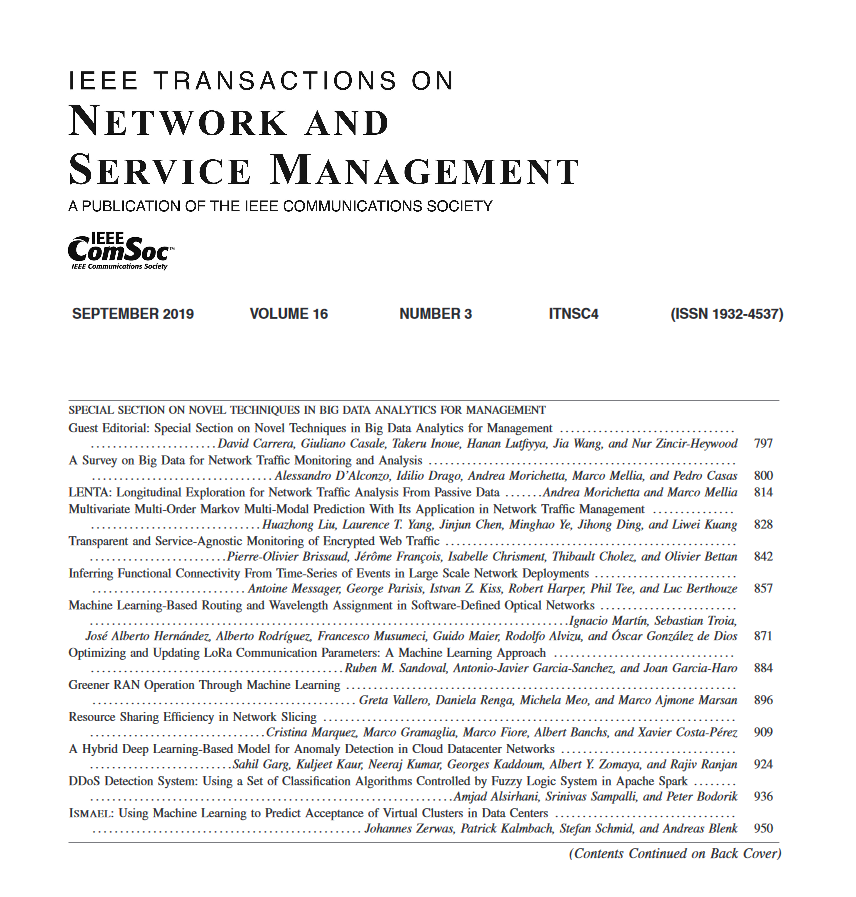分类模型在柔性网格光网络路由问题中的应用
IF 5.4
2区 计算机科学
Q1 COMPUTER SCIENCE, INFORMATION SYSTEMS
IEEE Transactions on Network and Service Management
Pub Date : 2025-04-01
DOI:10.1109/TNSM.2025.3556770
引用次数: 0
摘要
近年来,机器学习算法已广泛应用于光网络中,以解决路由、资源分配等复杂问题。在路由、调制和频谱分配(RMSA)问题中,机器学习算法可以用来学习历史数据中的模式,并找到好的解决方案,而不必探索所有现有的解决方案。本文提出了一种基于分类模型的弹性光网络路由算法。该算法根据呼叫请求信息和网络链路状态预测路由。通过动态路由算法获得用于训练提议的数据集。利用该数据集,根据路由的频率分布,使用不同的路由集对两个版本的提案进行评估。采用三种网络拓扑对路由算法进行了评估:六节点网络、NSFNET和欧洲光网络。结果与其他两种路由算法:Yen算法(k条最短路由)和基于频谱连续性的最短路径(SCSP)算法进行了比较。最后一种算法用于训练我们的提议。在阻塞概率方面,我们的建议在三种网络拓扑中优于Yen的算法。与SCSP算法相比,我们的提议在六节点和NSFNET网络拓扑中分别获得了15%和25%的平均性能提升。在欧洲网络拓扑中,我们的建议在最低网络负载下实现了23.19%的平均性能增益。在所有考虑的网络拓扑中,与SCSP算法相比,我们的建议减少了寻找RMSA解决方案所花费的时间。本文章由计算机程序翻译,如有差异,请以英文原文为准。
Classification-Model Applied to Routing Problem in Flexible-Grid Optical Networks
In recent years, machine learning algorithms have been widely used in optical networks to solve complex problems such as routing, resource allocation, among others. In routing, modulation and spectrum allocation (RMSA) problems, machine learning algorithms can be used to learn patterns in historical data and find good solutions without having to explore all existing solutions. In this paper, we propose an algorithm based on a classification model to solve the routing problem in elastic optical networks. This algorithm predicts the route according to the call request information and the state of the network links. The dataset used to train the proposal is obtained through a dynamic routing algorithm. With this dataset, two versions of the proposal are evaluated with different sets of routes according to the frequency distribution of these routes. Three network topologies are used to evaluate the routing algorithms: six-node, NSFNET and European optical network. The results are compared with two other routing algorithms: Yen’s algorithm (k shortest routes) and the spectrum continuity based shortest path (SCSP) algorithm. This last algorithm is used to train our proposal. Our proposal outperformed the Yen’s algorithm in the three network topologies in terms of blocking probability. When compared to the SCSP algorithm, our proposal obtained an average performance gain of 15% and 25% in the six-node and NSFNET network topologies, respectively. In the European network topology, our proposal achieved an average performance gain at the lowest network loads of 23.19%. In all network topologies considered, our proposal reduced the time spent to find the RMSA solution compared to the SCSP algorithm.
求助全文
通过发布文献求助,成功后即可免费获取论文全文。
去求助
来源期刊

IEEE Transactions on Network and Service Management
Computer Science-Computer Networks and Communications
CiteScore
9.30
自引率
15.10%
发文量
325
期刊介绍:
IEEE Transactions on Network and Service Management will publish (online only) peerreviewed archival quality papers that advance the state-of-the-art and practical applications of network and service management. Theoretical research contributions (presenting new concepts and techniques) and applied contributions (reporting on experiences and experiments with actual systems) will be encouraged. These transactions will focus on the key technical issues related to: Management Models, Architectures and Frameworks; Service Provisioning, Reliability and Quality Assurance; Management Functions; Enabling Technologies; Information and Communication Models; Policies; Applications and Case Studies; Emerging Technologies and Standards.
 求助内容:
求助内容: 应助结果提醒方式:
应助结果提醒方式:


